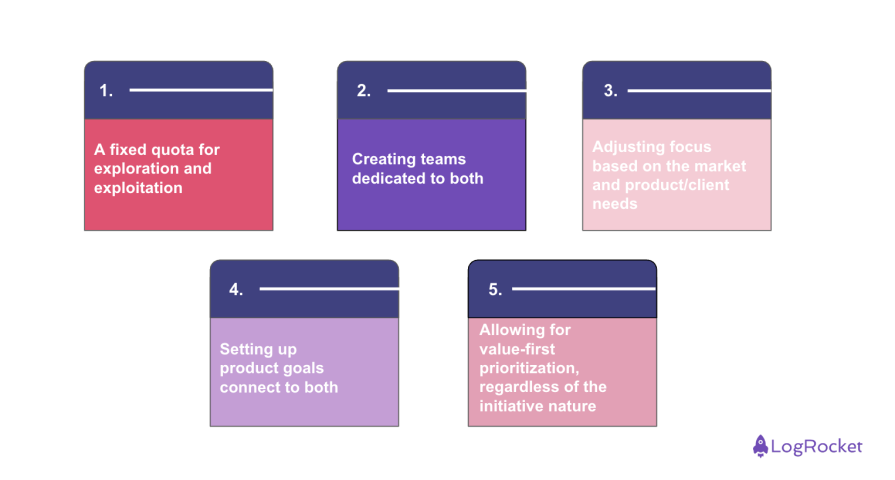When it comes to managing a product, you need to find the right balance between innovation and optimization. If you focus too much on new ideas, you might overlook refining what already works. On the other hand, if you only concentrate on optimization, you risk becoming obsolete.

How do you build this balance, and why is it so important? Keep reading for a guide to exploration and exploitation, as well as case studies of how successful companies manage them.
Exploration in product management is all about venturing into the unknown. It involves innovation, risk-taking, and experimentation to discover new opportunities and solutions. This could mean developing a groundbreaking feature, entering a new market, or adopting cutting-edge technology.
However, to do this, you need stakeholders and a company culture that enables investing in unproven ideas that could yield significant returns. Such exploration involves testing hypotheses through prototypes, MVPs, or pilot programs to gather insights.
As a PM, you might discover potential initiatives through:
Exploitation focuses on making the most of your current assets through a focus on efficiency, refinement, and optimization of existing products. This can also be as technical as changing technology or investing in making coding easier and faster for the developers.
To tackle exploitation, try the following strategies:
Finding the sweet spot between exploration and exploitation is crucial. Leaning too heavily on one can jeopardize your product’s success. The two extremes can lead to:

When you stop innovating and focus on optimizing existing product features things may seem optimistic at first. After all, the developers have been nagging you for ages to allow them to refactor a few parts of the code and fix a few, irritating niche bugs. What could possibly go wrong? Well…
While you and your team focus on exploitation, you risk a competitor hitting the jackpot with an innovative idea and stealing your clients. Even if this isn’t the case, your product may appear boring if nothing changes for months on end. Excessive exploitation might also get you in hot waters with your stakeholders, especially if the changes you make aren’t user-facing.
It seems reasonable then to direct available development capacity towards exploration as well. But what happens when you overcorrect?
It’s easy to proclaim the superiority of innovation, but focusing exclusively on it can also lead to disaster. Why? Well, for one thing, any new feature has a bigger risk of failure than improving new parts. Also, delivering a completed project with the proper quality can take too much time and create a release vacuum.
You also need to be wary about neglecting maintenance. A codebase that isn’t maintained (refactored) eventually becomes way more difficult to work with, causing long projects to become even longer with more unforeseen bugs.
Achieving a balance requires planning with a high-level overview. Here are some strategies to consider:
Implementing a fixed quota involves allocating a specific percentage of resources, such as time, budget, or personnel, to both exploration and exploitation activities. For instance, you might dedicate 70 percent of your resources to optimizing existing products and 30 percent for pursuing new ideas and innovations. This ensures that while you continue to refine and improve current offerings, there’s always a consistent investment in innovation to drive future growth.
By establishing separate teams focused exclusively on either exploration or exploitation, you allow each group to specialize and excel in their domain. Innovation teams can operate with the freedom to explore new product directions without the constraints of immediate ROI pressures, fostering a culture of creativity and risk-taking.
Meanwhile, maintenance or KTLO (keep the lights on) teams concentrate on enhancing and refining existing products, improving efficiency, and maximizing current value. This specialization ensures both areas receive the attention and expertise they require.
Market conditions and client needs evolve constantly. Adjusting your focus means being agile and responsive to these changes by reallocating resources between exploration and exploitation as necessary. If market trends indicate a demand for innovation, you might shift more resources toward exploratory projects.
Conversely, if clients seek improvements in existing products, focusing on exploitation becomes paramount. This dynamic approach ensures that your strategy remains aligned with external demands.
Integrating both exploration and exploitation into your product goals creates a balanced roadmap. By setting specific objectives for innovation (like launching a new feature or entering a new market) alongside goals for optimization (e.g., improving user satisfaction scores or reducing load times), you embed balance into the planning process. This approach ensures that your teams work towards a comprehensive vision that values both new developments and enhancements to existing products.
A value-first approach prioritizes projects based on their potential impact rather than categorizing them strictly as innovation or maintenance. This means evaluating all initiatives on criteria like return on investment, customer value, and strategic alignment. By focusing on the value each project brings, you ensure that resources are allocated to initiatives that offer the greatest benefit.
To get a better sense of how you can balance the two, pay attention to how these companies approached the issue:
Google exemplifies the balance between exploration and exploitation. While continually refining its search engine algorithms (exploitation), it also invests in innovative projects like Waymo (self-driving cars) and DeepMind (AI research). It’s also not shy about calling it quits on innovation directions that failed.
In fact, there’s an infamous “Google graveyard” of dozens of closed products, including the social network Google+ and game streaming platform Stadia.
Kodak’s downfall illustrates the risks of over-reliance on exploitation. The company focused heavily on film cameras, neglecting the digital revolution. This lack of exploration led to its decline as competitors embraced new technologies.
The same goes for Blockbuster as it refused to innovate, unlike its streaming competitor Netflix. In the end, the smaller company willing to take risks grew into a giant, whereas Blockbuster slowly disappeared.
Balancing exploration and exploitation isn’t just a strategic choice; it’s a necessity for sustainable product growth. By innovating, you keep your product fresh and competitive. By optimizing, you ensure efficiency and customer satisfaction.
Striking the right balance allows your product to thrive today while preparing for the challenges of tomorrow. Invest time in both areas, and you’ll position your product for long-term success.
Featured image source: IconScout

LogRocket identifies friction points in the user experience so you can make informed decisions about product and design changes that must happen to hit your goals.
With LogRocket, you can understand the scope of the issues affecting your product and prioritize the changes that need to be made. LogRocket simplifies workflows by allowing Engineering, Product, UX, and Design teams to work from the same data as you, eliminating any confusion about what needs to be done.
Get your teams on the same page — try LogRocket today.

Most teams fail at autonomy. Learn how clear rules help product teams move faster without micromanagement.

A practical framework for PMs to use AI in ideation without sacrificing judgment, strategy, or decision quality.

A practical five minute revenue estimation method to help product managers compare ideas, drop low impact features, and prioritize smarter.

A practical guide for PMs who want to stop being bottlenecks, delegate smarter, and lead teams effectively with a clear ownership framework.